By Benjamin Nobel, March 3, 2017
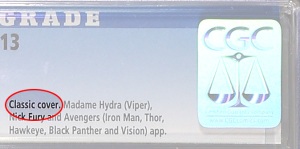
“Classic Cover” phrase on an example CGC label.
“Classic Cover” — we’ve all seen this phrase on CGC/CBCS/PGX labels for older comics, and we probably paid a little more than we otherwise would have, to own the particular comics that are denoted as such by the comic book “authorities” who decide such things.
But there’s a whole world out there of comic book covers that are “too modern” (too recent) to be given this notation… yet eventually will arguably deserve it (with the passage of enough time).
A question I therefore find fascinating to ponder, is this: Which more modern comic book covers have the markings of what will eventually be recognized as “Classic Covers” looking back from the distant future?
Or maybe that future isn’t as distant as we might think…
I recently noticed that Spider-Man #1 (1990) — a comic that definitely evokes the word “classic” in my own mind when I picture it — is now denoted officially as a “Classic Cover” by the grading company PGX. Take a look:

Spider-Man #1 (1990) is among the more modern comics PGX now denotes with “Classic Cover” on slab labels.
I don’t know precisely when PGX began doing this, but the above comic has a grade date of 10/2016… and the below PGX-graded example of the same issue has a grade date of 11/2014, where you can see they did not yet denote them this way back in 2014. So this narrows it down to sometime in the past couple of years (maybe the 25th anniversary of publication, perhaps?) that PGX said, effectively, “Yep: it is now time… Spider-Man #1 is now officially a Classic Cover in our view.”

At 11/2014 the “Classic Cover” designation was not yet being applied by PGX.
And Spider-Man #1 is not alone in receiving this honor — in fact, I found that Amazing Spider-Man #300 also now gets the “Classic Cover” notation by PGX. Incidentally, look what else PGX denotes as well for this particular example copy below (I’ve circled it in red):

PGX denotes Amazing Spider-Man #300 as a “Classic Cover” on their labels.
These are two very forward-thinking notations by PGX, in my opinion: Amazing Spider-Man #300 is absolutely deserving of Classic Cover status if you ask me, and, PGX’s decision to denote newsstand copies with “Newsstand Edition” puts PGX on the correct side of comic book history in this regard.
Because to highlight that the copy in question is the more-rare, more-desirable, and more-valuable newsstand version (as opposed to the common Direct Edition version), makes a great deal of sense, especially in light of the growing market value difference between the types [see about half way down the following post for example recent sales of ASM #300 demonstrating how the market value of the newsstand edition has grown much higher than the prevalent direct edition: “Nice book, too bad it’s a direct edition” ; and if you are not already in-the-know about the difference between direct edition and newsstand comics then I recommend you immediately stop what you’re doing and read the following link because comprehending this distinction is perhaps the single most critical piece of information any collector should know about bronze/copper/modern age comics… without understanding this distinction exists, in my view you’re “flying blind” when collecting modern comic books: Comic Book Newsstand Editions: Understanding The Difference ]
Observation: Spider-Man #1 (1990) and Amazing Spider-Man #300 Have Something In Common
These two recently-designated (by PGX) “Classic Covers” have something in common — something beyond the legendary Todd McFarlane as the artist (but that certainly helps)! 🙂
But what else these two books also have in common, is how they both fall into what I think of as a “category” of comic books: books whose covers are so special/important, that they are the basis of “cover swipes” by others.
That’s an important category — and so critical to the rest of this post that I want to pause here and re-state it another way to make sure I’m getting my point across:
First: An artist (or team of artists) creates a comic book cover… Next: with the passage of time, that cover attains a degree of notoriety/fame/recognition… and then, Finally: a future comic book cover is created that uses that original — that “classic” — as the inspiration or basis for a fresh “take” on the original. Often, that fresh take is a different character in the same pose/style, or the same character under different circumstances or costume choices. The later/future comic book cover would be considered a “cover swipe” of the original.
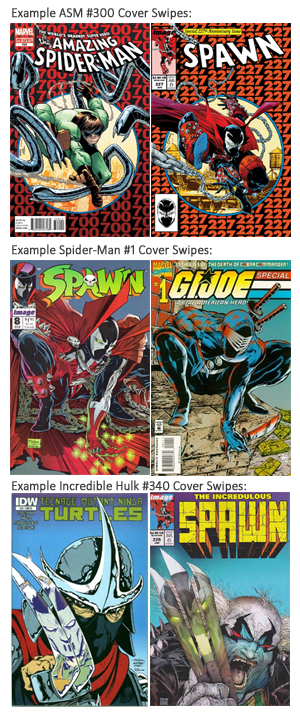
Examples from among the many many different cover swipes you’ll find out there, of Amazing Spider-Man #300, Spider-Man #1, and Incredible Hulk #340.
When you stop to think about it, being cover swiped is an excellent test of being deserving of future Classic Cover status down the road. It is like a form of “peer review” — other creators (or even the original creators themselves) are essentially telling us just how important that past comic cover is… i.e. it is so great, so important, and/or so absolutely classic, that they decided to pay homage to it by putting their own “twist” on the original… their own twist on the classic!
What better “future classic cover test” can there be than that?!
Let’s call this “the cover swipe test.” And both Spider-Man #1 and Amazing Spider-Man #300 pass that “cover swipe test” with flying colors. As does McFarlane’s Incredible Hulk #340 — where I couldn’t find a recent PGX label to verify, but, it certainly seems to me this issue would be another that they’d be very likely to label as a Classic Cover. Shown at right are just a handful of the cover swipes you’ll find out there for these three McFarlane classics.
So now, with this introduction having been laid down, you’ll see what the remainder of this post is going to be about… It starts with asking the question: What other comics have covers so important that they’ve been swiped by others?
There’s obviously lots… way too many to cover them all in one post. But I’m going to cut that universe way down — I’m going to narrow it by applying one more filter. For this particular post, what I’d like to do is highlight 7 examples of comics that each also have something else in common: the existence of a more-rare variant version distributed on newsstands, from out of one “class” or another of variants that I’ve covered on this blog… i.e. from out of the various categories of special situations where CGC “breaks out” newsstand comics as distinct census entries versus their common direct edition counter-parts.
So, presented now, in no particular rank/order…
7 Comics Destined For Future Classic Cover Status — And Their Rare Variants
#7 — Batman #423
Let’s stick with Todd McFarlane for now to start off the list — why not, the man is a genius! And in addition to his famous work on Spider-Man and Hulk at Marvel, McFarlane was actually over at DC for a period of time as well… where he created one of the greatest Batman covers of all time:

Batman #423, future Classic Cover candidate, by Todd McFarlane. Rare and CGC-recognized $1.00 Canadian Price Variant pictured.

For the example copy of Batman #423 above, please notice that the cover price is $1.00 instead of the 75 cents you might have expected — that means the copy is a CGC-recognized variant having its own distinct Census entry, where the count of graded copies increments distinctly from the rest of the print run. In other words, $1.00 cover price copies are “broken out” by CGC separately (much like they break out other cover price variants like the 35 cent variants of 1977 as distinct entries versus their “regular” counterparts). These $1.00 copies were actually newsstand exclusives… distributed only through the newsstand distribution channel, as the copies intended for distribution on newsstands in Toronto, Vancouver, and other parts of Canada.
And Batman #423 just happens to be the last (chronologically) of the 1980’s Canadian Price Variants published by D.C., whose dual-batch newsstand window lasted longer than Marvel’s 1980’s variant window did [related: 95¢ and $1.00 DC Price Variants: How Do We Know What They Are?]. Incredibly, at September 1988, we’re four months past the publication date of Amazing Spider-Man #300!

Think about this for a moment: For Amazing Spider-Man #300, published 5/1988, Marvel had already ended their own dual-batch newsstand publication window, so newsstand copies of ASM #300 have both US and Canadian prices on them. In other words they’d already merged the two batches of newsstand copies into one batch with both prices shown, instead of two single-price batches.
Newsstand sales had been trending down so much, that by the middle of the decade (around 1985), direct edition copies flooded the specialty comic shops in quantities that began to outnumber newsstand comics. By 1986, Jim Shooter was struggling to try and save the ailing newsstand channel; by 1987, we’re told that only the most dedicated newsstands continued to carry comics at all, and we see a newsstand rarity percentage estimate of 30% (versus 70% direct edition) for 1987. And here we are talking about a comic published in September of 1988 with Batman #423.
That dramatic decline in newsstand sales during the 80’s definitely helps explain why high grade newsstand copies of ASM #300 are so much harder to find, versus direct edition copies (and therefore with that relative rarity, why they’re so much more valuable). There’s also the notorious newsstand destruction rate in play, where even though 30% of sales might have been newsstand by 1987, the treatment of those newsstand copies by buyers (and staff) was much different as compared to the direct edition copies sold in comic shops.

“Our experience has shown that the comics sold in comic shops had a 90% probability of being put into a plastic bag and preserved, while comics purchased from newsstands had a 90% probability of either being read to death, or thrown away.” ~ Chuck Rozanski
The newsstand rarity difference is having a visible impact on the market prices we witness out there for top graded newsstand copies of Amazing Spider-Man #300, versus top graded direct edition copies. For example in this recent post I examined the sold listings section of eBay and determined that the highest recent sale prices ASM #300 has achieved have been newsstand copies in 9.8, while direct edition copies in 9.8 lag that high value in a derivative fashion.
So if newsstand copies of ASM #300 — which were single-batch with both US and Canadian prices on them — fetch a dramatic market premium for their relative rarity as compared to the prevalent and well-preserved direct edition copies, then how should we think about Batman #423 newsstand copies which were divided into two batches (a larger batch with 75 cent cover prices on them, and then a small batch with $1.00 cover prices on them sized to serve the tiny Canadian market)?
Clearly, if newsstand in general is more rare and more valuable by 1988, as illustrated by ASM #300, then Canadian price variant newsstand is so rare by contrast as to blow our minds! Remember, Canada’s population was only 9.8% of the North American market for newsstand comic books at the time (the U.S. being the other 90.2%)… so rounding up, rough math would be about one tenth of the total newsstand copies of Batman #423 would be expected to be the $1.00 cover price copies. And remember, those $1.00 cover price copies were only found on newsstands, because the Direct Edition copies sold across the US and Canada were identical and carried both prices. So it is a tenth of whatever the newsstand percentage was in 1988 that we’re talking about for $1.00 cover price copies — and remember, we saw an estimate of 30% newsstand by 1987… a tenth of 30% is 3%. And we’re now a year+ later in time with Batman #423, so we could potentially be as low as 2% if we carry that newsstand-decline-trend forward with the same magnitude [by the way, 2% is “1:50” to put it in “modern variant terms”].
And if you actually go looking for $1.00 cover price copies of Batman #423 in the marketplace, or go looking for them on the CGC census, that dramatic rarity is confirmed by observation: in fact, as of this writing, you can count the number of $1.00 cover price copies on the CGC census for Batman #423 on two fingers. Here’s the current numbers for first print copies of Batman #423 ($1.00 cover price copies were produced simultaneously, on the same equipment, and are therefore first print copies; CGC breaks them out with the notation “Canadian Edition” on census):

Current census snapshot as of this writing, for Batman #423. Chronologically, this is the latest 1980’s issue to have a newsstand-exclusive Canadian Price Variant at DC.
Yep, when it came to comic book rarity, it was much better to have been a kid who rooted for the Blue Jays as their home team, versus a kid who rooted for the Yankees as their home team! Because even though at the time it might have felt like they were being charged quite a lot for comics — that higher cover price being on account of the currency exchange rate — those kids living in Toronto and elsewhere in Canada took home a drastically more rare type, assuming they made their purchases on newsstands.
So here with Batman #423 we have an incredibly rare and CGC-recognized variant that can be sought for the issue number, and coming back to the theme of the post, the issue number has what I consider to be a cover destined for future “Classic Cover” status — and as shown below, it indeed passes our cover swipe test.
Example cover swipe: D.C. Universe Rebirth, Batman #1, by Barry Kitson:
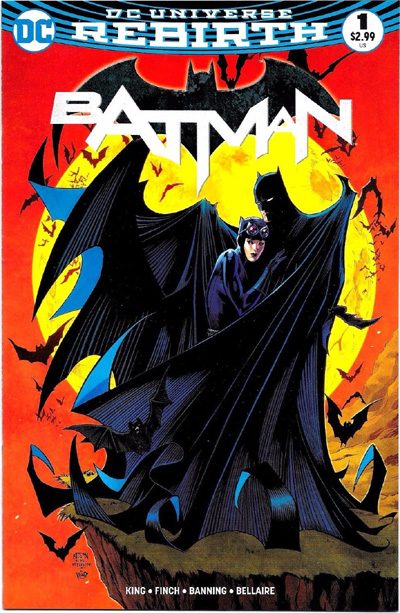
Example cover swipe of Batman #423, by Barry Kitson.
#6 — X-Men #207
Jumping back over to the Marvel universe now, and the Uncanny X-Men in particular, with issue #207: What a fantastic work of art by John Romita Jr. and Dan Green, and featuring the popular Wolverine, this ranks highly on many a collector’s personal list of favorite covers. It also happens to pass our “cover swipe test” and have a rare CGC-recognized variant version out of the 80’s cover price variant window (this time with the variant having a 95 cent cover price, versus the expected 75 cents; just 1 variant copy presently exists on CGC’s census as of this writing):

Published 7/1986 by Marvel, a newsstand-exclusive Canadian price variant indeed exists for X-Men #207, carrying a cover price of 95 cents instead of the expected 75. As of this writing, just 1 copy exists on census, a 7.0.
Example cover swipe: Wolverine #310, by Ed McGuinness:

Example cover swipe of X-Men #207: Wolverine #310.
#5 — Secret Wars #8
Amid the chaos, there comes… a costume! This issue also happens to be the #1 most-submitted mega-key of the 1980’s with the existence of a rare CGC-recognized variant, this time with the variant copies carrying a $1.00 cover price versus the expected 75 cents:
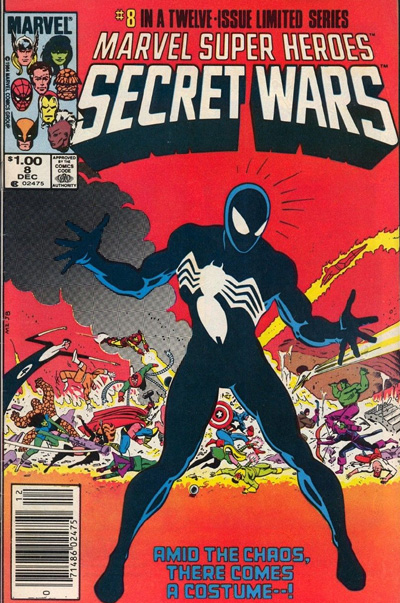
Secret Wars #8 variant with $1.00 cover price.
There are just so many cover swipes out there of this issue it is hard to choose one to highlight as an example swipe… but I’m going to show you the below HeroesCon variant to highlight how sometimes, the creators of the original cover will cover-swipe themselves.
This is a pretty neat occurrence when it happens, because in a way, it is like the creators are teaching us which past covers of theirs they find to be most important. Wouldn’t it be fantastic if we had a list of super-star creators and their own personal favorite covers they’ve created? I’d pay money to see such a list! While self-cover-swipes aren’t necessarily telling us the favorite of a given superstar creator, they definitely tell us “a” favorite, so looking out for instances of creators cover-swiping themselves can be very interesting and very telling about how they feel about the importance of the original.
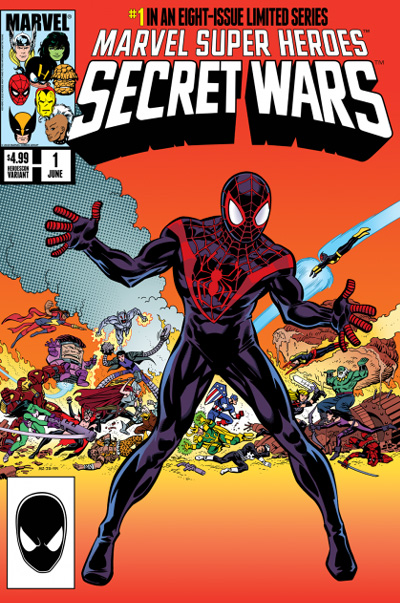
Example cover swipe, by Mike Zeck and John Beatty themselves!
As a side note, although the cover price shown on the above HeroesCon variant is $4.99, these were actually sold by the HeroesCon organization for $20/ea:

The actual price to buy one of these HeroesCon variants was $20, not the $4.99 price shown on its cover.
I think that the pricepoint for the above variant (in contrast to what you can find out there from the 1980’s cover price variant window with that same budget) really highlights the relative value in the marketplace today of the CGC-recognized newsstand variants I’ve talked about on this blog, because in contrast to “modern day incentive variants” where the rarity is more of a “manufactured rarity” (by purposely restricting the supply) and the initial buyers pay through-the-nose to own the comic, by contrast Canadian price variants and other forms of CGC-recognized newsstand variants have a “naturally occurring” rarity, one where the original buyer did pay the original cover price shown on the cover.
So for the $1.00 cover price Secret Wars #8 variant, the original buyer paid a dollar — it wasn’t as if the incredible rarity as a newsstand-exclusive cover price variant was known at the time of sale to those who bought them. Instead, the original buyer, as a newsstand-goer (because the $1.00 variants were newsstand exclusives), likely just bought it to read it. A collector buying comics on newsstands was the exception, not the norm.
That’s why we get the huge destruction rate that newsstand comics are notorious for, with our 1980’s Canadian price variants… it was simply an entertainment purchase for most buyers (they might not have kept it at all when they were done reading it), which stands in stark contrast to something like the HeroesCon variant I highlighted above, where the original buyer shelled out a full $20 on day one. That’s a collectible purchase at that $20 price, where the original buyer would be highly likely to preserve their copy.
And indeed, if you look online at the CGC census today, you’ll find that a great many of the buyers of that HeroesCon variant sent their copy in to be slabbed. The number of HeroesCon variants that attained the 9.8 tier is full 14x the number of $1.00 variant Secret Wars #8 copies in 9.8 on census today! The chance of a Canadian price variant surviving in 9.8, in the context of how they were distributed (on newsstands exclusively), has got to be incredibly slim indeed.
The contrast between modern-day incentive variants and 80’s Canadian price variants is absolutely stunning to me, where I can count on my fingers the grand total number of variant copies I’ve seen hit the marketplace over the past year for the 7 classic cover contenders highlighted in this post (I maintain eBay alerts for them), and meanwhile, for example, HeroesCon can sell 500 variant copies at $20/ea in a virtual snap of the fingers.
And when one of the collectors who bought a HeroesCon variant goes to sell it, they’re arguably not going to be very eager to part with it for less than $20. Meanwhile, an original owner of a Canadian cover price variant comic might not even realize that they own a rare and CGC-recognized variant! When they go to sell it, they might therefore give it away at “regular” prices (i.e. price their copy for sale for what the issue number at large goes for) — thereby creating a huge value opportunity for those of us who are cognizant of just how rare these higher cover priced copies really are, with original sales likely to have only been in the range of 2-7% of copies sold of each issue, depending on the year, and with the notorious newsstand destruction rate coming into play from there.
Start hunting for Canadian price variant comics in the marketplace and you’ll be amazed what you can take home with a $20 budget when the seller is unaware of what they own! At the time of this writing, I checked eBay availability for each of the Canadian price variant comics I highlighted here in this post, and found price variants on the market for two that can be landed for under $20 today, where the seller does not title their listing accordingly — in other words you cannot find them by searching eBay on “___ Canadian” or “___ variant” but instead you have to look through all the listings for the issue at large, pause on newsstand copies, and check their cover prices yourself in order to find your variant [this practical guide may help you: Canadian Price Variants — How To Spot Them ].
#4 — Alpha Flight #3
As I was saying earlier, it really would be terrific if we had a list of superstar creators and the personal favorite cover created by each of them, wouldn’t it? Think about how helpful that list would be, to some future people tasked with forming an updated “classic cover” list to include more modern examples!
Take John Byrne for example… how amazing would it be if he were to actually come out and tell us his personal favorite cover that he’s created? If you and I were tasked with updating a list of classic covers to include more modern comics, and John Byrne was to tell us his personal favorite that he’s created, how would we treat that input? Would we dare say “thanks anyway but we disagree” and exclude his personal favorite cover, whatever it may happen to be? Not a chance! That comic would go right onto our list, to mark a key work from a key superstar.
One hint Byrne has already given us about an important cover of the past, comes from Alpha Flight #17, and falls under the category we saw earlier of a creator cover-swiping an issue they themselves helped create… so via seeing the below, we could definitely pencil down a contender that might rank among Byrne’s favorite covers:

Alpha Flight #17 (75 cent variant).
Above is Alpha Flight #17 (and I’ve pictured the 75 cent variant). Notice that this is actually a cover-swipe of X-Men #109, an issue number where Byrne was part of the artist team:

The original cover upon which Alpha Flight #17 was based.
Similarly, I have to wonder whether Byrne’s incredibly cool cover for Alpha Flight #13 (one of my favorite Byrne covers) drew inspiration from X-Men #141?

Alpha Flight #13 (75 cent variant).
Here’s a zoom-in on X-Men #141:

X-Men #141
So perhaps through his artwork Byrne is giving us hints about important past covers for issues he’s worked on… Still, it would be great if Bryne was to come out and tell us his all-time personal favorite cover he’s drawn, wouldn’t it?
Guess what? He has told us! In this post:

John Byrne writes: “Alpha Flight #3 stands to this day as my favorite of all the covers I have done.”
So there it is, published for all the world to see, John Byrne’s personal favorite of all the covers he’s ever done… is Alpha Flight #3! And as you probably already figured out, there is indeed a rare newsstand-exclusive CGC-recognized variant with 75 cent cover price instead of the expected 60 cents:

Alpha Flight #3, 75 cent variant.
Leave it to Byrne to come up with a cover so cool, so interesting, but also so structurally complicated and fascinating, that I wonder if this particular cover is even swipeable? It would be a real challenge for sure, for another artist to swipe!
#3 — Thor #337
Here’s another 1980’s mega-key, featuring the first appearance of Beta Ray Bill and an iconic cover by Walt Simonson! Falling right within the 75 cent variant window, the variant for this issue shows up on CGC’s census with rarity of just 1.7% of total copies they have graded to date (as of this writing, 32 variants appear versus 1800 regular copies). This issue along with Thor #338 may be among the earliest-recognized-to-exist 75 cent variants in the hobby, cited all the way back in an 1998 article about 35 cent variants.

Thor #337 (75 cent variant).
Example cover swipe: Hulk (2008) #42, by Ariel Olivetti:
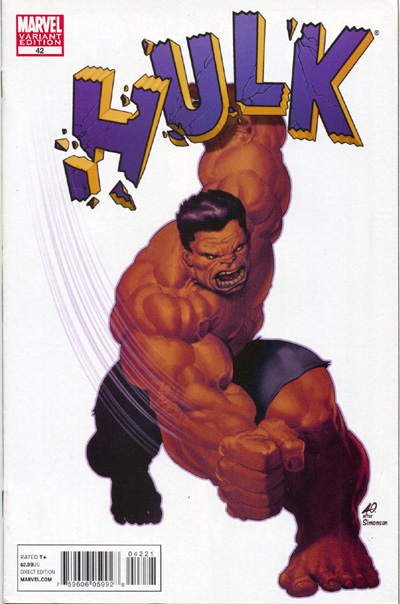
Example cover swipe of Thor #337: Hulk #42.
#2 — Savage Dragon Limited Series #1
For those of us who were collecting comics in 1992, travel back down memory lane with me to the intense excitement leading up to the launch of Image Comics. Superstar creators broke away from the major publishers and were introducing new superheroes… Todd McFarlane, Rob Liefeld, Erik Larsen, Jim Lee, Marc Silvestri, Jim Valentino, Whilce Portacio — some of the biggest names in the industry, and the suspense we all felt to see the #1 issues from different creators was intense.
When some of these titles finally arrived at the comic shops, fellow collectors were practically in a frenzy. Remember how you felt seeing the cover of Youngblood #1 for the first time, or Spawn #1, or Savage Dragon Limited Series #1? For fellow Savage Dragon fans out there, I’m going to highlight that last one below — and for me, there was something particularly magical about that cover. Fast-forward to comic collecting as an adult, I was so pleased when I found out that newsstand copies were manufactured differently, represented only a tiny fraction of total sales, and are a CGC-recognized variant! What a great way these rare newsstand copies are, to re-collect these Image Comics classics but with a relative-value / relative-rarity approach! As of this writing there are 7 “Newsstand Edition” copies on the CGC census for Savage Dragon Limited Series #1.

Newsstand Edition copy (CGC-recognized variant; UPC code on cover), of Savage Dragon Limited Series #1, by Erik Larsen.
Example cover swipe: Spawn #220, by none other than Todd McFarlane:

Example Savage Dragon Limited Series #1 cover swipe: Spawn #220.
#1 — Amazing Spider-Man #606
At the time ASM #606 was published, the cover price was ‘supposed’ to be $2.99 for this issue number… Look anywhere online in places that show what the cover price is ‘supposed’ to be and you’ll see a $2.99 price for this issue everywhere you look today; for example here’s MyComicShop:

MyComicShop notes a $2.99 cover price for this issue.
Here’s Atomic Avenue:

AtomicAvenue entry for ASM #606: cover price: $2.99.
Here’s ComicsPriceGuide.com:

ComicsPriceGuide also lists a $2.99 cover price for this issue.

$3.99 cover price copies were distributed under the “Friendly Neighborhood Spider-Man” UPC code (as opposed to “Amazing Spider-Man”), meaning newsstand outlets needed to have ordered the Friendly title to get any copies of issue #606.
So anywhere you look today, your expectation is that for issue #606 of Amazing Spider-Man, the cover price you’ll find out there is $2.99. And for the vast majority of copies that’s correct… that vast majority being Direct Edition copies.
But as regular readers of this blog are well aware, for issue #606 and many others (#607 also for example too), there are actually also copies out there with $3.99 cover prices on them… a dollar higher! And they were newsstand exclusives! CGC “breaks out” such copies as “$3.99 Newsstand Edition” on census (read more about this entire “class” of newsstand-exclusive CGC-recognized cover price variants).
Here’s a $3.99 cover priced copy; cover by J Scott Campbell:

$3.99 Newsstand Edition copy (UPC code is that of Friendly Neighborhood Spider-Man), of Amazing Spider-Man #606.
Example cover swipe: Renew Your Vows #4 by Siya Oum:

Example ASM #606 cover swipe: Renew Your Vows #4.
So There’s 7 Future Classic Cover Contenders!
Now, Back To McFarlane…
This post began by pointing out that PGX has started to denote Spider-Man #1 (and Amazing Spider-Man #300) with “Classic Cover” on their labels — then I talked about how cover swipes are a form of creators effectively teaching us which past covers are particularly important. But if we back-test the “cover swipe test” for these two comics, would it have worked early on? Let’s find out!
So let’s travel back in time to shortly after Amazing Spider-Man #300 and Spider-Man #1 were published. If we were using this “cover swipe test” concept as a “marker” for future classic cover contenders, back then, would we have caught these two comics? And when? Would we have caught them relatively early, or would we have been waiting around forever? In fact, we would not have waited around very long at all before these two issues would have made our list.
Take a look at the cover of Incredible Hulk #344 — this sure seems to have drawn inspiration from ASM #300, and is therefore a cover swipe, wouldn’t you say?

Early cover swipe of Amazing Spider #300: Incredible Hulk #344, by Todd McFarlane and Bob Wiacek.
And then of course within the Amazing Spider-Man title, we then got this cover:
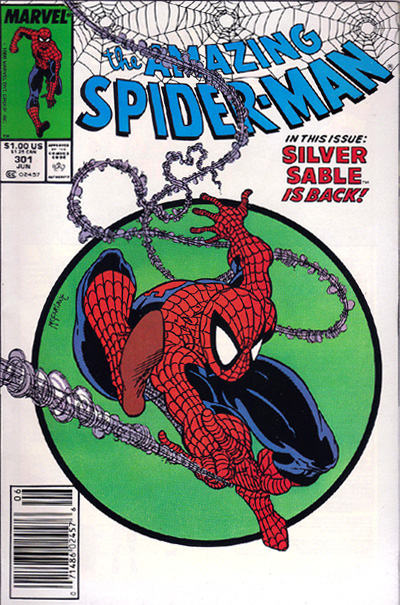
Amazing Spider-Man #301, with Spidey back to the original costume.
As for Spider-Man #1, not long after it was published, Todd McFarlane reprised that great original cover at issue #13, this time with the return of the black costume:

With Spider-Man #13, McFarlane cover-swiped himself!
McFarlane went on to again cover-swipe Spider-Man #1, with Spawn #8 (and note that a CGC-recognized “Newsstand Edition” variant is broken out for Spawn #8):

McFarlane again cover-swiped Spider-Man #1, at issue #8 of Spawn. Under his name, note that it says “After Me” 🙂
So very early on both of these issues that PGX now denotes with “Classic Cover” — Spider-Man #1 and ASM #300 — would have passed the cover swipe test. It would have been decades from there before PGX’s decision came — after all, a comic has to be some amount “old enough” before it makes sense to refer to it as a classic, but that delay just means our test worked, and we’d have had plenty of collecting time back then to work on obtaining some nice copies! And going after copies with UPC codes on them would have been a great theme; for Spider-Man #1, the Gold copies with UPC codes have become particularly valuable (those Gold UPC coded copies were distributed exclusively at Walmart).
Todd McFarlane sure seems to have enjoyed working on cover swipes — below is his cover for ASM #306, a cover swipe of Action Comics #1:

McFarlane’s cover for Amazing Spider-Man #306 is a cover swipe of Action Comics #1.
Another important cover carrying a McFarlane art credit (together with Rob Liefeld) is New Mutants #87 (1st Cable as an adult — see X-Men #201 for his 1st appearance as Baby Nathan and look for the 75 cent variant). It didn’t take long before Liefeld swiped that cover, for Youngblood (issue #5 of the second series):

New Mutants #87 cover swipe: Youngblood #5.
It is always neat to see an artist reprising an earlier work by cover-swiping it! Before the Batman #423 cover swipe I highlighted earlier, McFarlane himself cover-swiped it for Spawn #230:
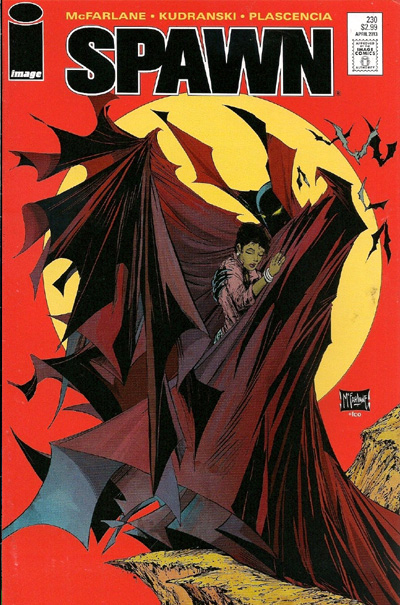
Batman #423 cover swipe: Spawn #230.
As I hope all of these many examples help to illustrate, there is a never-ending stream of cover swipes out there. My 7 highlighted examples merely scratch the surface [7/13/2018 update: here’s two more mega-key examples]. I’m sure some readers of this post have other great examples that immediately come to their own minds, and are thinking at this point, “how could ___ not have been one of the seven Ben chose to highlight!?” (Fill in the blank… maybe Hulk #377 as yet another example out there of a future classic cover contender).

Incredible Hulk #377 cover swipe: Fantastic Four #601.
For sure, there are a great many others, and I definitely do not intend the ones I highlighted in this post to be an exhaustive list by any means or even a “top” seven. They were just seven examples of my choosing, where I did first narrow down the universe by looking at contenders with CGC-recognized rare newsstand and cover price variants in existence for the issue.
Even within the intersection of future classic covers and rare cover price variants there are certainly many other examples beyond those I’ve presented here, and then outside of that intersection the universe opens up even more. Hopefully with the seven I presented I’m going to spark your own ideas. Right within the Secret Wars series for example, I’ve also seen issue #4 cover-swiped:

Secret Wars #4 cover swipe: Deadpool’s Secret Secret Wars #1.
Many important “key” comics are themselves cover swipes, for example within the 80’s cover price variant window we see that Amazing Spider-Man #252 is a cover swipe of Amazing Fantasy #15:

Amazing Spider-Man #252 (75 cent variant pictured) was a cover swipe of Amazing Fantasy #15, but with Spider-Man wearing the black costume.
And then outside of the special situations where CGC “breaks out” newsstand comics, we’d enlarge the universe of future classic cover contenders even further. So let this post be more of a jumping off point than anything else, to come up with your own ideas of future classic cover contenders to collect! And when you see a new cover swipe come out, think too about collecting the original and whether there’s a more-rare version of it that you can target.
Painted Covers
Finally, before bringing this post to an end, I want to make mention of a category of comic book covers that I’m particularly fond of: painted covers. Some of the comic book covers derived from paintings by artists, are simply classic works of art to my way of thinking. And by applying a newsstand-focused collecting approach, it is possible to arrive at a collectible with rarity that in a sense has similarity to an actual fine art painting, in the uniqueness of what it is possible for you to own. Let me explain what I’m getting at. Take, for example, Amazing Spider-Man #641, one of my all-time-favorite comic book covers, by the talented Paolo Rivera.

Amazing Spider-Man #641, painted cover by Paolo Rivera.
Even though CGC does not “break out” newsstand copies of this particular issue as a distinct census variant, collectors can still discern the rare newsstand copies from their prevalent direct edition counterparts anyway, on our own… by looking at the UPC code box (direct edition copies will have the words “Direct Edition” towards the top of this box just under the price, while newsstand copies like the one pictured above will instead have the word “Newsstand”).
To illustrate my point, imagine I ask the entire collecting world to raise their hand if they own issue #641 of Amazing Spider-Man (lots of hands go up, including my own). Now I ask the entire collecting world to keep their hand raised, if they own the newsstand edition, but to lower their hand if their copy reads “Direct Edition” on it below the price tag. Now very few hands remain raised, simply because by the time ASM #641 was published, a minuscule fraction of total copies sold by Marvel were newsstand. Now suppose I ask the entire collecting world to keep their hand raised if their newsstand copy has been graded 9.8 by CGC. At this point I have to wonder how many hands are still raised besides mine? If I layer on Signature Series, and ask how many have a 9.8 Signature Series newsstand copy signed by the cover artist, it is very possible my own hand is the only one still raised (but I have no way of knowing for sure, as CGC does not break them out on census).
So by applying a few collecting “themes” it is very possible to take a comic book with a future classic cover (or simply a gorgeous work of art), and narrow yourself down to a collectible where much like a fine art painting, you own something one-of-a-kind (at a fraction of the cost of a fine art painting). [Here’s a few other examples of incredible painted covers by Rivera].
For many of the examples I highlighted in this post, there are zero Signature Series copies on record of the variant — so it is literally still possible to become the one and only collector, for example, to own a Canadian-Edition-labeled $1.00 cover price Signature Series copy of Batman #423 signed by Todd McFarlane… All you’d have to do is acquire a $1.00 cover price copy, submit it to the next Todd McFarlane Signature Series signing, and become the first person in the world to own one like it. You’d have something entirely unique that nobody in the world owns today, at least as I write these words in March of 2017 (nearing 30 years since the comic was originally published)! A pretty neat collecting concept, if you ask me!
Happy Collecting! 🙂
Cover Swipes Slideshow — the examples from this post presented side-by-side original-by-swipe




Excellent article. Very accurate. When the newsstands had the two prices, there was the American and Canadian prices, and not U.K. I believe the American and Canaian copies were printed at the same time, but UK I don’t think so. When they finished printing the North American comics they changed the blades for the foreign comics, and this is why the cutting on the U.K. Comics have sharper edges. U.K editions were printed last. You see a lot of U.K. People trying to raise their own profile to increase their value of their comic books. This of course is completely false, and the North American comics were printed first. I would ask Jim Shooter if one doesn’t believe. Sorry U.K. It is what it is
LikeLike
Hi Jimmy, thanks for reading and commenting! Interesting to think about the probable order of each batch during the different eras — and for Pence variants they spanned such a huge timeline that perhaps in different periods the situation varied? There were those “Marvel All Colour Comics” banner ones for example, where, if you look at X-Men #101 as an example below, these varied not just in the black/key plate but also in the background color of that top banner; by contrast, the 1970’s and 1980’s cover price variants differ only in the black/key plate:
While reading your comment about printing order, it prompted me to recall once reading the opposite view to what you wrote (i.e. the opposite view being that Pence comics were likely printed first), and I dug up the article where I read that opposing view… here’s a relevant quote from the article followed by a link to it:
“The sequence in which this happened may have varied, but a number of people have pointed out the likelihood that the pence price variant covers were in fact printed first, based on the fact that the initial output at any printing press may get messed up, and that Marvel and DC would, from a business point of view, rather have had that happen to the British distribution lot than to the home market print run.”
From: http://www.wymann.info/comics/060-PencePriceVariants.html
Another factor I wonder about is the fate of unsold copies. For the price variants among North American newsstand copies, experts have told us they were typically over-produced because they couldn’t know in advance how well a given issue would sell, didn’t want to under-produce after all the costs were incurred to create the issue, and that any returns in North America could simply be pulped/recycled forward. But across the pond, what was the situation? I don’t know enough to answer, but I do observe that once the bar code strike-through was introduced in 1979 to distinguish non-returnable Direct Editions from newsstand copies, the Pence batch all have the strike-throughs (and then eventually the logos). Another quote from that same article, talking about returnability:
“Returnability of unsold pence price variants, even if offered in some ways, must have been tricky – with the obvious result that copies stayed on display until eventually sold. This is how and why I myself was able to pick up Iron Man #86 (May 1976) at a newsagent in Fort William in September 1976, and Crypt of Shadows #21 (November 1975) and Chamber of Chills #25 (November 1976) together in September 1977 at the newsagents of a servicing area on the M4 motorway southbound. These horror comics both were the final issues of their title, so maybe this also helped keep them on the lowest shelf for almost two and one year respectively beyond their cover date.”
Thanks again for reading and commenting!
Happy Collecting! 🙂
– Ben
LikeLike